Yoshimura history -27
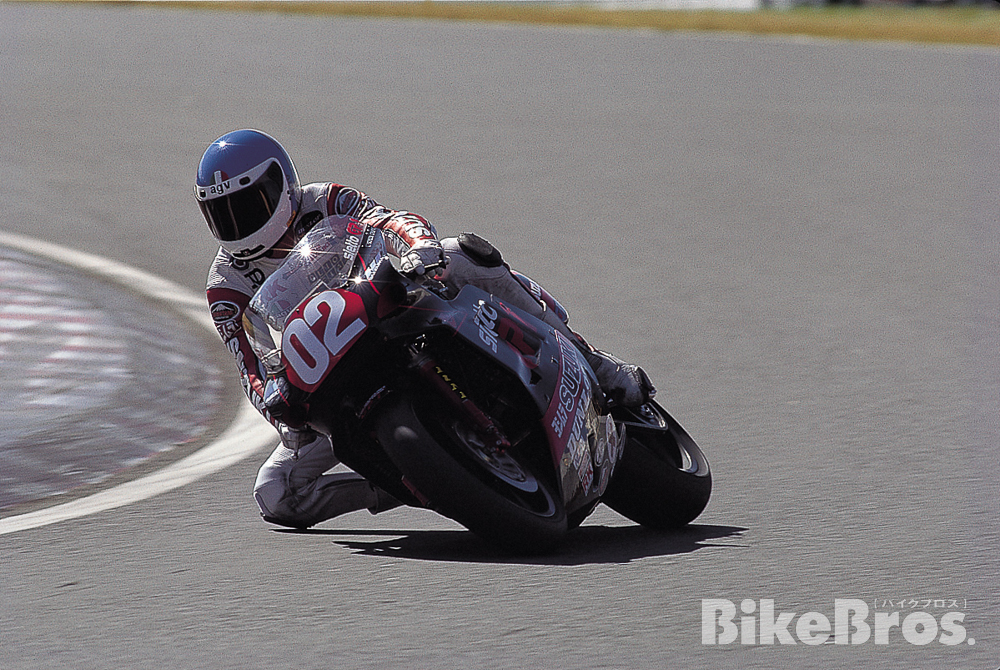
For Doug Polen, two races a day was a piece of cake. At the TBC Big Road and MFJ Grand Prix in 1988, he made a double entry in the TT-F1 and TT-F3, and in the 1987 AMA races, he made triple entries in the Superbike, 750 Supersport and 600 Supersport classes, and at local races it was common for him to enter 6 or 7 races per day. Racing numbers starting with a zero indicate that it is a spot entry.
Photo courtesy of Takao Isobe.
Polen Makes His All-Japan Debut and Wins 2nd Place in Suzuka 8H
1988 Part 2: Another Texan Makes His Debut in All-Japan Championship.
In 1988, a total of 15 races were scheduled for the All-Japan Road Race Championship, with 6 of these being the International A-class TT-F1 and 8 being the International A-class TT-F3. In order to challenge the three-time consecutive champion Yoshimura Suzuki, all the other Japanese Motorcycle Big Four –––– Honda, Yamaha and Kawasaki –––– sent their cutting-edge factory machines to the TT-F1 class, turning the All-Japan and Suzuka 8 Hours into battlegrounds for the world’s best 4-stroke racing bikes. Yoshimura continued to race with the TT-F1-spec oil-cooled GSX-R750 (built on the chassis made by Suzuki’s Hamamatsu headquarters), however, the engine used was not based on the newly developed φ73mm-bore short-stroke type, but rather the earlier φ70mm-bore engine (since the TT-F1 allows for a 1% increase in displacement through boring, φ70.3mm pistons were actually used).
As for Team Yoshimura riders, 1987 All-Japan TT-F1 Champion and 3rd ranked TT-F3 rider Yukiya Oshima is the team’s ace in both classes. Additionally, Yoshimura entered Katsuro Takayoshi, who came 2nd in the 1987 Suzuka 8 Hours and ranked 8th in the All-Japan TT-F1 and 3rd in the TT-F3, and Hisatomo Nakamura in the TT-F1 race, and Takeshi Ando in the TT-F3 race. Nakamura and Ando were the winning pair in the 1987 Suzuka 4 Hours (riding a Yoshimura Suzuki GSX-R400).
The opening round of the 1988 TT-F1 series was set to be held relatively late, as it was combined with the All-Japan Road Race Championship Round 4 (April 24th) at Suzuka. Oshima had been physically and mentally affected by his fall at Turn 1 in Daytona in March. Just as he had struggled to find the right front-end settings in Daytona, he was having trouble finding the right chassis settings this time too. It was no surprise, as Team Yoshimura’s test run at Suzuka was only an hour long on the East Course, which was clearly not enough. Even during the qualifying session, the staff from the suspension manufacturer were there to help with adjustments. Despite this, Oshima did well, qualifying in 6th place and finishing 4th in the final race. Takahashi, who was also struggling, fell during the qualifying round and qualified in 15th place. He also did not do well in the final race, finishing 14th.
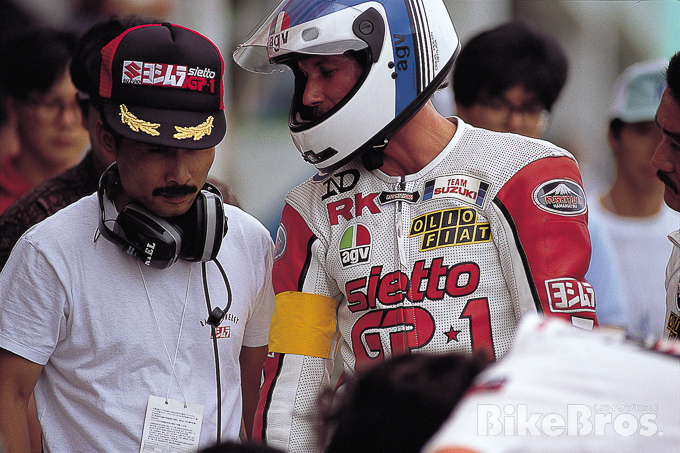
Fujio (left), as a theoretical tuner, favored Polen (right), who would meticulously analyze the race, the machine, and the race’s development, and never pushed himself too hard, but still managed to achieve the best results. He was an entirely new type of rider for Yoshimura.
Photo courtesy of Osamu Kidachi.
The second round of the TT-F1 (the 8th round for the All-Japan) was the Suzuka 200km (June 12th), which is considered to be a kind of prelude to the Suzuka 8 Hours. Team Yoshimura chose to prepare for the 8 Hours by entering Polen in place of Takayoshi, who was still recovering from his injuries, and also entered Oshima and Nakamura, but the team did not do well in the qualifying round, with Polen’s 11th place being their highest.
The Suzuka 200km race consisted of 35 laps, with the standard strategy being to make a single pit stop to refuel and tire change. It was raining at the start of the race, so all the bikes took off on rain tires. After 18 laps, the top group began to make pit stops. The rain stopped shortly after that, and the track quickly began to dry out. The teams were all in a state of confusion, with ex-Yoshimura rider Shoji Miyazaki (Blue Fox Honda RVF750) changing his rear tire from rain to rain, and then to cut-slick. Through this chaos, privateer rider Tadashi Oshima (Blue Fox Honda CBR750) won the race, wearing the same pair of rain tires from start to finish, no matter how worn out they became. Team Yoshimura suffered a crash and retirement for Nakamura, with Yukiya Oshima finishing in 8th place and Polen in 11th.
TT-F1 Round 3 was organized into the 7th round of the All-Japan series (July 12th) at Sugo. Due to the delayed rainy season, it turned out to be a wet race, just like the Suzuka 200km. With the rain ceasing and the track surface gradually drying out in the final, Miyazaki who had changed his rear tire from rain to cut-slick on the grid, made a mid-race charge to take his first international A-class victory. Second place went to Tadashi Oshima, who is strong in the rain. Yoshimura took on the race with a three-bike team of Yukiya Oshima, Nakamura and Takayoshi, who had returned from injury, but the team finished with Oshima in 7th place, Takayoshi in 13th and Nakamura in 14th.
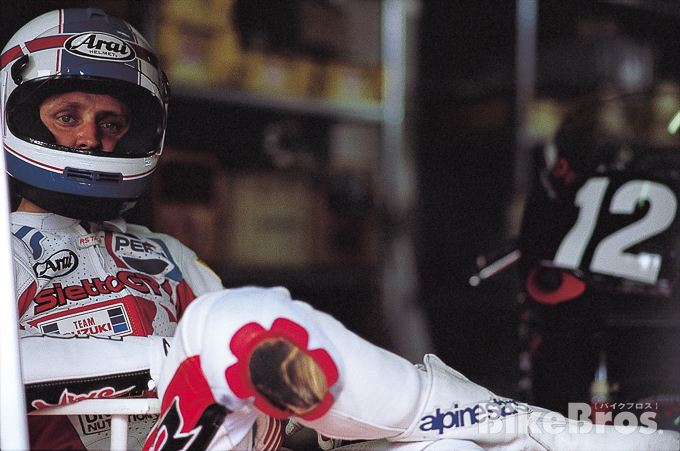
Kevin Schwantz continued to compete in the Suzuka 8 Hours even after he moved to the 500 Grand Prix. He competed from 1985 to 1989 with Team Yoshimura, and in 1992 with the Team Lucky Strike Suzuki (Suzuki factory).
Photo courtesy of Osamu Kidachi.
Then came the 1988 Suzuka 8 Hours (July 31st). Yoshimura Suzuki entered two machines, with Doug Polen and Grand Prix rider Kevin Schwantz riding the #12, and Oshima and Takayoshi riding the #45. While this might have appeared to be a lineup that was sure to win, Schwantz, the ace rider, had broken his right knee in a crash at the Belgium GP (July 3rd), and there were concerns about how well he had recovered. Schwantz still managed to set the third fastest time on Saturday, the second day of qualifying, so if he had been in top form, he could have set the fastest time. The rider who set the fastest time was his arch-rival Wayne Rainey (Lucky Strike Roberts Yamaha YZF750, with Kevin Magee), with second fastest going to Wayne Gardner (HRC Honda RVF750, with Niall Mackenzie).
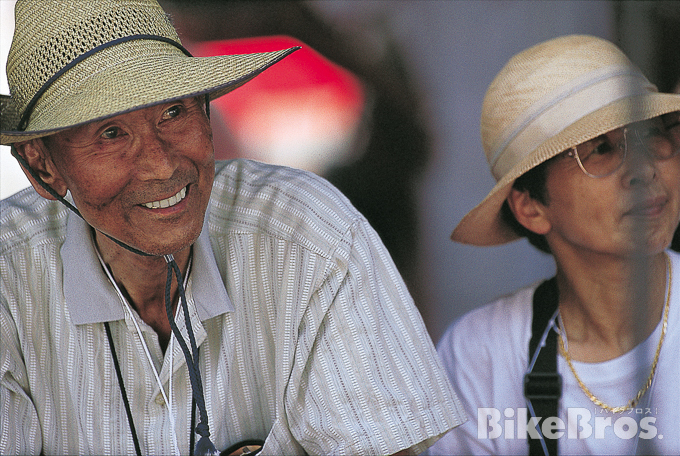
Pop and his wife, Naoe, at the 1988 Suzuka 8 Hours. It may have been a while since the couple last smiled so happily together, after he was diagnosed with a lung disease in 1985.
Photo courtesy of Osamu Kidachi.
From the first stint of the final race, things were anything but predictable. Schwantz, who was the starting rider, came in to the pits after about 32 minutes (15 laps), and was replaced by Polen following a refueling and front and rear tire change. Today, the Suzuka 8 Hours is usually run with pit stops every hour (7 times in total), but at the time, there were two strategies: 8 stops and 7 stops. Perhaps out of consideration for Schwantz, who was still recovering from a broken right knee, Yoshimura decided to go with a strategy of 8 pit stops, and ended the first stint early.
The race was led by Gardner, Rainey and Michael Dowson (Y.R.T.R. Yamaha YZF750, with Kunio Machii), with Mick Doohan (TECH21 Yamaha YZF750, with Tadahiko Taira) following slightly behind. The positions kept changing depending on the timing of each team’s pit stops, but #12 Yoshimura was basically battling for 5th position. Neither Schwantz nor Polen were able to put in lap times that would allow them to compete for the top positions. In the battle for the lead, Rainey overtook the seemingly invincible GP500 world champion Gardner and gradually pulled away from the rest of the pack.
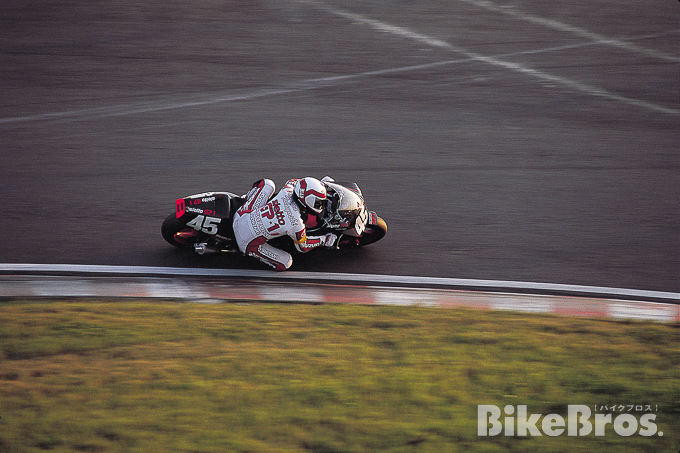
Takayoshi was not at his best in 1988, both in the All-Japan and Suzuka 8 Hours, partly due to his injuries. He finished 22nd in the Suzuka 8 Hours, riding with Oshima.
Photo courtesy of Takao Isobe.
Rainey / Magee pair was ahead of the rest. On the 105th lap, Gardner, who was in 2nd position, stopped due to engine trouble on the ascent of Dunlop Corner. He pushed his bike up the 7.8% incline to take a shortcut to the pit and retired from the race. For the battle for 2nd place, #21 Yamaha (Taira / Doohan) was chasing after #12 Yoshimura, but with 11 minutes remaining in the final stint for both teams (Schwantz on Yoshimura vs. Taira on Yamaha), Taira’s machine came to a stop just before the S-bend. The pale purple #21 was forced to retire from the race, making it the third time this had happened to Taira. The winner was #3 Lucky Strike Roberts Yamaha YZF750 (Rainey / Magee), with #12 Yoshimura Suzuki Sietto GP-1 GSX-R750 (Schwantz / Polen) in 2nd place, one lap behind the leader, and #9 Kawasaki France ZXR-7 (Pierre-Étienne Samin / Adrien Morillas) in 3rd place. The top three teams all made 8 pit stops, while the #1 Minolta Suzuki GSX-R750 (Hervé Moineau / Thierry Crine) in 4th place made 7 pit stops. #12 Yoshimura finished on the podium, but with Schwantz suffering an injury, they lacked the speed to take the top spot. #45 Yoshimura finished the race in 22nd place.
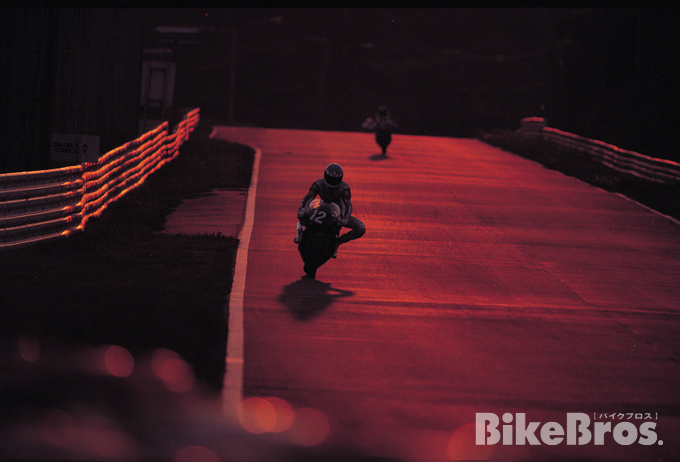
Polen approaching the 130R from the back straight as it is dyed red by the setting sun. The most beautiful place and time at the Suzuka 8 Hours.
Photo courtesy of Takao Isobe.
Then, the 1988 Suzuka 8 Hours Race Week entered its second half. As for the All-Japan Road Race Championship series, there were two F3 races before the F1 race, and one of these was combined with the inaugural FIM Superbike World Championship, aka SBK. In the SBK Japan round held at Sugo on August 28th, Yoshimura rider Oshima and Yoshimura-supported rider Gary Goodfellow (Don Knit Sugano GSX-R750) took part. In Heat 1, Goodfellow came in 1st, Oshima 3rd, and in Heat 2, Goodfellow came in 3rd, Oshima 13th, demonstrating the outstanding performance of the Yoshimura machines. The winner of Heat 2 was Doohan (Marlboro Yamaha FZR750).
Polen took part in the Round 4 of the All-Japan TT-F1 (he also competed in the remaining two rounds of the TT-F1 this season) held at Suzuka on September 11th. He had run on Michelin tires at the previous Suzuka 200km, but this time he ran on Dunlops, which he was familiar with from the AMA races, and was the only rider to record a time in the 2’17” bracket (2’17″921), earning him pole position. In the final race, he skillfully controlled the gap to the second-placed rider, eventually winning by a comfortable enough 3.812 seconds. Oshima finished in 7th place.
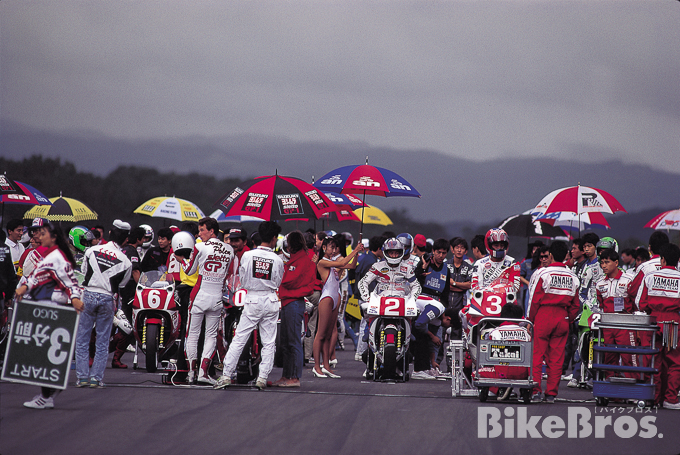
1988 TBC Big Road Race starting grid. From right to left: #21 Sohwa (Kawasaki) in P5 on the second row, #3 Machii (Yamaha) in P2 on the first row, #2 Miyazaki in P6 on the second row, #05 Polen (showing his back and looking to the left) in P3 on the first row, his wife Dianne and mechanic Takagi next to him, and #6 Saito (Yamaha) in P7 on the second row.
Photo courtesy of Takao Isobe.
The TT-F1 Round 5 (the 14th round for the All-Japan) was held on October 9th as the TBC Big Road Race at Sugo. In addition to Yoshimura’s Polen, this race also saw the participation of future world-class riders such as Doohan from Yamaha and Aaron Slight from YSP Mejiro (a Yamaha dealer team) riding a Bimota YB4. In the qualifying round, the Yamaha factories were strong, with Doohan taking pole position and Machii in 2nd position. Polen was 3rd and Oshima 8th. In the final race, a crash occurred at Turn 3 of the opening lap. Polen, who had managed to avoid the incident, took the lead, but on the second lap he was overtaken by Doohan, who went on to win the race with a comfortable lead. Polen calmly chose to hold on to 2nd place. Oshima rode tenaciously to finish in 5th place. Polen also entered the TT-F3 and finished in 6th.
Before the final round of the All-Japan series, there was a race event called the Fuji Super Sprint on October 23rd, and in the TT-F1 class, Yamaha factory riders Doohan and Dawson achieved a 1-2 finish. Polen took 3rd place on the podium. Goodfellow came 7th and Oshima 9th. The winner of the GP500 class was Schwantz.
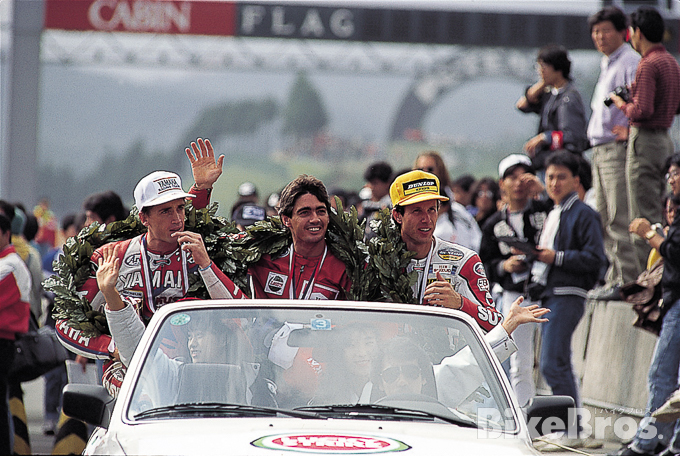
Victory Parade at the 1988 Fuji Super Sprint. From left to right: 2nd place Michael Dawson (Yamaha), winner Mick Doohan (Yamaha), 3rd place Doug Polen (Yoshimura).
The final round of the 1988 All-Japan Road Race Championship, the MFJ Grand Prix, was held at Tsukuba on October 30th. While most courses are 4km long (Suzuka being 6km), Tsukuba features a 2km course, which is an extremely short one for the TT-F1 class, with lap times in the 57-58 second range. In the qualifying round, Machii, who was in top form, took pole position, and Polen took P2 on the grid. Only these two riders recorded times in the 57-second range. Oshima was 5th and Goodfellow was 7th.
As expected, the final race became a head-to-head match between Polen and Machii. Machii had been defending his lead since the 9th lap, but on the last lap (Lap 25), Polen brilliantly took the inside of the Hairpin 1 to take the lead and won by 0.11 seconds, marking his second All-Japan victory. Oshima, who had won a close battle, came in 3rd, and Yoshimura riders occupied the top two places on the podium. Polen also entered the TT-F3 class and took a remarkable 3rd place, making it onto the podium in both classes.
On the 1988 All-Japan Ranking, Oshima was 4th, Takayoshi was 24th and Nakamura was 26th in the TT-F1 class. In the TT-F3 class, Ando was 4th, Oshima was 9th and Takayoshi was 14th. The results were far from what they had been aiming for. Meanwhile, Polen, who was competing on a spot basis and therefore did not receive any points, was more than enough to be considered a great success.
With the 1989 season approaching, Yoshimura made a decision to have Polen obtain an MJF license and compete in the All Japan series full-time. Although it was an unorthodox strategy, the odds were high.
Published on June 9, 2024
Stories and photos supplied by Yoshimura Japan / Takao Isobe / Osamu Kidachi
Written by Tomoya Ishibashi
Edited by Bike Bros Magazines


